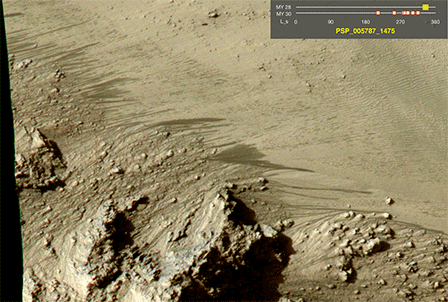
SKY REPORTER: Mars Fever!
I recently read: “NASA to Announce Mars Mystery Solved” and it made my heart beat faster. Had proof of Martian life been found? If not living, breathing, and pumping out methane, at least some solid evidentiary trace from eons ago—that could be the greatest scientific discovery ever. However, the heralded news conference September 28, led by James L. Green, director of NASA’s planetary science division, revealed no such evidence. Nevertheless, details were revealed about a place on the red planet where water recently flowed—not the ultimate revelation but perhaps a step in that direction.
For years it’s been known Mars’s atmosphere contains traces of water vapor, and during a five month period in 2008 water ice was found by the Phoenix Laboratory after gently setting down at northern Martian latitude 68.22°. It’s an icy place, whimsically dubbed Green Valley indicating a relatively safe landing site as opposed to a rock strewn, dangerous area for a spacecraft.
Phoenix discovered a frozen water layer five to eighteen centimeters beneath the surface after digging with the laboratory’s robotic arm. Minerals and salts amounting to several percent of the soil’s weight that only could have been formed in water were also identified. At the end of that Martian summer, snow and ice began covering the site and subsequently destroyed the lander’s ability to communicate with Earth.
Despite previous knowledge about water on Mars, recognition of recently flowing water was a big step in our quest for evidence of possible extraterrestrial life. Streaks about 100 yards long, described as “recurring slope lineae, or RSL” are visible on images of Horowitz Crater at 32.04° S 219.36° W. The crater was named after Norman Horowitz, a geneticist at the California Institute of Technology, who designed Pyrolytic Release experiments aboard Viking lander craft that reached Mars in 1976. That mission initiated the first direct analysis of Martian surface properties and specifically looked for biosignatures of microbial life. Initial reports of positive results spurred enduring debate, general denial, and motivation for more direct experimentation.
Read more from the SKY REPORTER
GIF: NASA/JPL
Notes
temporalvagabond liked this
narwhalsarefalling reblogged this from astrophysics-daily
 reconscout117 liked this
reconscout117 liked this dreamxofxada reblogged this from astrophysics-daily
 the-demon-colonel liked this
the-demon-colonel liked this wellwhydontcha reblogged this from astrophysics-daily
neverbrevity-blog liked this
the-loneliness-of-a-timelord reblogged this from astrophysics-daily
the-loneliness-of-a-timelord liked this
cap-nomad reblogged this from astrophysics-daily
 papale-marilu-blog liked this
papale-marilu-blog liked this certainly-an-insane-writer liked this
cosmic-raes reblogged this from astrophysics-daily
samibabe33 reblogged this from astrophysics-daily
samibabe33 liked this
 shipwreckedincomatose reblogged this from astrophysics-daily
shipwreckedincomatose reblogged this from astrophysics-daily hisohiso-blog2 liked this
 angelabeckett2 liked this
angelabeckett2 liked this  modestinvader liked this
modestinvader liked this giselypenov liked this
yannielli liked this
5n1tchandaspy liked this
bitsyforthewin reblogged this from astrophysics-daily
bitsyforthewin liked this
snowfox001 liked this
ladyaudiophile reblogged this from awolfbeneath
ladyaudiophile liked this
awolfbeneath reblogged this from astrophysics-daily
 unwastelandunbaby liked this
unwastelandunbaby liked this amnhnyc posted this
- Show more notes
